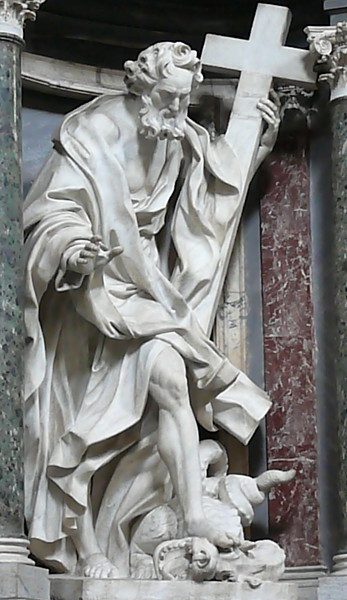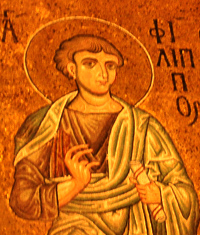NARRATIVE IMAGES
The saint figures importantly in chapter 8 of the Acts of the Apostles, first preaching successfully in Samaria and then teaching and baptizing a visiting official of the Ethiopian court. So far, I have seen no images of his preaching and only one of the Ethiopian's baptism, although the official does appear in this image in which he accompanies St. Matthew in Ethiopia. A stained glass window at Canterbury has Philip telling Nathanael about Jesus, "him of whom Moses in the law and the prophets did write."Most other narrative images focus on the two parts of the legendary material. The left side of the picture above follows the first part: In Scythia the saint is commanded to worship an idol of Mars. At the base of the idol's pedestal sits a dragon whose evil breath has killed many Scythians and sickened others. Philip tells the Scythians if they will destroy the idol he can make the dragon go away and revive the men it has killed. They pull down the idol, and Philip is able to save the city, whereupon thousands of Scythians listen to his sermons and are converted.
In the second part of the legend, Philip finishes his earthly life in Hierapolis, Phrygia. A goodly number of medieval texts refer to his death with phrasing similar to that in the mosaic above: IN PACE QUEVIT, which can mean either "he rests in peace" or "he went to his rest in peace." The Early South English Legendary assumes the latter meaning: "In peace he died in his bed: as the book us hath told." But most medieval writers assert that he was crucified. One of the vitae presented in the Acta Sanctorum's article on Philip adds that he was fastened to the cross with crosswise cords; another adds that he was stoned while on the cross.1 Following this tradition, most images of the saint's death have him tied to a cross (example) and some add the stoning (example). In the Golden Legend the Hierapolitans "fastened him to the cross, like unto his master," implying the use of nails. This suggestion is followed in the great painting of his crucifixion in the Conti Chapel in Padua. In most images of Philip on the cross he is fully dressed, in a long shift or loose trousers with a short tunic.
PORTRAITS
Western portraits of St. Philip usually have him holding a tall cross, and they often also include the dragon, as in the first picture at right. He may be portrayed as a man in middle or advanced age (example), but sometimes in the West and consistently in the East he is a beardless youth with a somewhat long face and a tousled or bifurcated forelock, holding a scroll in his left hand while he blesses the viewer with his right, as in the second picture at right. Even the narrative image at the top of this page presents a young and beardless Philip with a bifurcated forelock holding a scroll and forming his right hand into a blessing gesture.
Prepared in 2015 by Richard Stracke, Emeritus Professor of English, Augusta University.
HOME PAGE
St. Philip and the Idol of Mars, in St. Mark's Cathedral, Venice. See the description page for a full explanation.
OTHER IMAGES

Mazzuoli, St. Philip, 1795-11 – See the description page.

St. Philip: Detail from a Byzantine-style mosaic in Monreale Cathedral, Sicily. (See the description page.)
ATTRIBUTES
- Tall cross
- Dragon
MORE IMAGES
- Already in a 12th century carved column Philip is pictured with his long cross.
- 13th century (est.): In the Apostles Window in Regensburg Cathedral, Philip is attached to his cross by ropes that tie his wrists and ankles.
- 1420-30: Statuette of Philip with a long, broad cross.
- 1487-1503: For the Strozzi Chapel in Santa Maria Novella, Florence, Filippino Lippi painted The Crucifixion of St. Philip (where the saint is tied to the cross at the wrists and ankles) and St. Philip at the Temple of Mars. With collaboraors he also made a stained glass window for the chapel portraying Philip with St. John the Evangelist.
- 1539-40: Philip and his long cross are included in Saviati's Madonna and Child Enthroned with Saints.
- 18th century: Statue in St. Peter's Church, Munich
- 1722-23: Pietro Uberti illustrates a variant account of Philip's death in his St. Philip Beaten by a Soldier.
- Undated: Portrait in an Austrian church.
DATES
- Feast day: May 1 originally and among Lutherans and Anglicans; for Catholics the date was moved to May 11 in 1955 and then to May 3 in 1969.
BIOGRAPHY
- Golden Legend #65
- Early South English Legendary, 364-65
- Acta Sanctorum, May vol. 1, 7-18. A Latin version at pages 11-12 closely resembles those in the Golden Legend and the Early South English Legendary. A Greek version, pages 12-14, details the saint's relationship to Jesus and then skips to Hierapolis without mentioning Scythia or a dragon. In both versions Philip is crucified.
- P. Batiffol, "Actus S. Philippi Apostoli." Analecta Bollandiana, IX, 204-50.
- Roman Breviary: 1908 English translation, II, 839-40; 1632 Latin version, 854-57.
NOTE
1 ESEL, 364 (my translation). Acta Sanctorum, May vol. 1: 10, 12, 14.
